
2024, Rain Mountain Press
Rising from the wreckage of poverty, ignorance, and sexual predation, the women’s lives presented here in lyrical scenes reveal extraordinary truths. Despite being dug out of the deep past, women today continue to face the same demons in different costumes. Dickinson’s latest book will shake you. It torpedoed my mind.
—Susan Isla Tepper, Author and Playwright
In this dazzling sequence of vignettes, Stephanie Dickinson highlights the darker aspect of a high-octane existence and illuminates the interior worlds of Jean Harlow and Bessie Smith. Imagine becoming the star you admire and finding out how it hurts. The scenes are bound together by the electric force of the writing, whether to illuminate the cost of being glamorous or facing up to the KKK with the same power Bessie had in her singing voice. All the momentary drama is here, and language whose beauty is razor sharp. The closing section eludes the spotlights, but not indignities that can befall anyone. There is a lyric force throughout the book that makes art into a sensual delight, even as the material from which it draws is rendered unflinchingly.
—David Chorton, author of Speech Scroll and Shatter the Bell in my Ear (Translations from Christine Lavant)
Stardom is not all it’s cracked up to be. Dickinson references biographical moments in the lives of Harlow and Smith and then dives deep. She delves into their inner lives revealing the pain and humiliations each of the women encountered. Part stream of consciousness, part inner monologues – we are pulled into their innermost fears and struggles. Dickinson faces the dark side head on and illuminates it.
—Maude Boylan, Actress
In "Houston Insomnia" Stephanie Dickinson demonstrates her remarkable powers of description and narration. Her intense vivid imagery and compelling characters are so enthralling they keep you riveted to the page. She is among the best prose stylists writing fiction today.
—Dorothy Friedman August, poet and non-fiction essayist
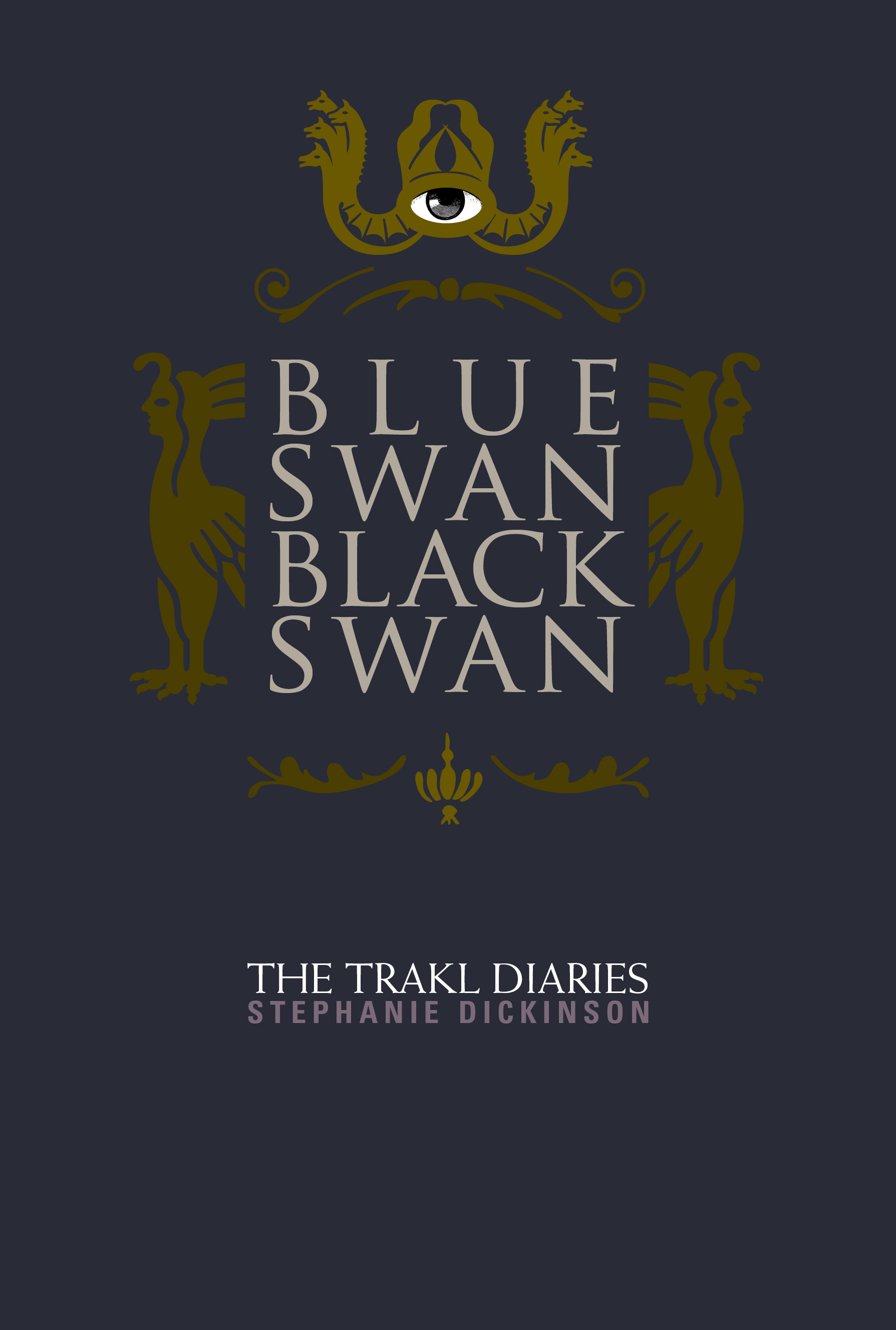
2021, The Bitter Oleander Press, fiction
War, mental illness, narcotics, sickness, incest and a deep passion for poetry were all a part of the Austrian poet Georg Trakl’s short and tragic life (1887-1914). Biographical accounts have been few, vague and speculative. So little is clearly known about the man that much in this regard has been supplanted by what can be only assumed from the poet’s substantial volume of work. The great German poet, Else-Lasker Schüler, who was a friend of the poet, wrote in her two line elegy: “Georg Trakl died by his own hand in the war. / That was how lonely he was in the world. I loved him.” In Blue Swan, Black Swan: The Trakl Diaries, Stephanie Dickinson opens a new door, but not one into Trakl’s psyche, rather from out of his psyche as if it were him relaying the incidents as they occurred in each particular moment and which these poems more than aptly provide. All is as if it originates from his mouth, from his dictation onto the pages of what is meant to be read as his unwritten diary. So powerful and precise is Dickinson’s language that at times you cannot distinguish between what she says and what you imagine Trakl would have said. The intensity level is that analogous. Dickinson’s intimacy with such a tragic poet’s life acts to offer us Trakl himself speaking about something we never knew in such detail and which we the reader have only her to thank for sharing with us.
—Paul B. Roth, The Bitter Oleander Press
Morning drags on. There’s hell in staying awake, her eyelids weigh more than winter bedding. Minutes disintegrate, rolling over and down a dusty, winding road. The black rocks jut, no longer disguised as alpine and spruce. An ancient carriage stops her tumbling. The coachman gives her a hand up; holes gape under the seat, springs poking her as if wiry ferns allowed to creep. She hears voices, old men muttering. The horses run wild and the carriage clatters. Her six children have shrunk, she can fit them now inside a cup, which makes no sound as she waves it through the air. A blackened piece of walnut falls. Soon, she will visit Greece. The pottery she seeks will smell of white crumbly cheese and the cloth it was aged in, the burning of dry plaster over the fire of the sea.
—from Blue Swan, Black Swan: The Trakl Diaries
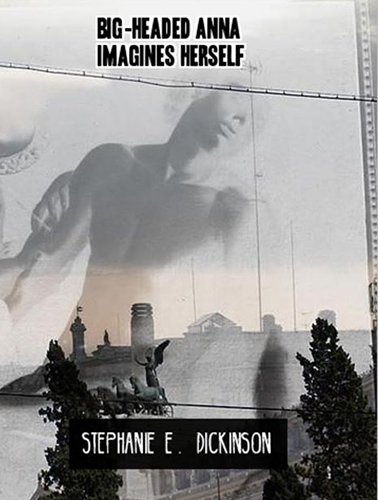
2019, Alien Buddha Press, fiction
We are introduced to Big Headed Anna at birth. Her child mother, boy bodied suffers in child birth. Her baby’s head so big that Anna’s feet were roped to free her from the womb, upon looking at her the young mother fled. Anna took to a cow when left for dead, survived to go on. Or so it is imagined by Anna.
Dickinson has crafted a series of flash fictions that chart the adventures of Big Headed Anna through time and space, of viewing the living and dead, of the life of an outcast from birth who encounters a wide array of characters. Imagined or real? For many who take the time to read this vivid collection, who have suffered from the cruelty of human kind there will be no doubt that the life of Anna could be real. Dickinson’s use of flash fiction to tell the story is simply brilliant as are the images and metaphor that populate this collection.
Big Headed Anna suffers the indignity and violence of rape, unable to see her attacker, a bag covering her head. And when she gives birth, her child stolen from her, carried away her only comfort is knowing the child has a normal head. Many of the flash describe her efforts to find her child.
Dickinson has weaved these stories together as a master quilter, each strand interwoven, each resulting image full of color and metaphor. The stories take place between 1900 and 1933, a harsh time in America, a harsh time for those who appear a bit different from the majority, a harsh time for the poor during a time of exurbanite wealth and decline. Although dream like in its presentation the supporting characters are developed with words and images reflecting a beauty and realism to this work. Yet like a master quilter, Dickinson has created a body of work in this collection always with an underlying love for its central character.
from a review by g emil reutter
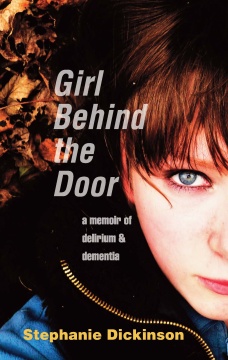
2017, Rain Mountan Press, memoir
Girl Behind the Door opens with the renegade Iowa farm girl who ran away to New York City to be a writer returning home to find her dying, nearly 100-year-old mother lying naked on a bed in the Memory Care Unit of a nursing home. Despite the haunting beauty of Dickinson’s language, naked is possibly the best way to describe her prose. Naked emotion. Naked observation. The warts and the pimples of living presented with the same intensity and honesty as the finely curved hips and thick auburn hair that give life its pleasure. No one writes like Stephanie Dickinson, except maybe God.
Alice Jurish
The great state of Iowa has raised many chickens, but Stephanie Dickinson sure as rain isn’t one of them. Bravely tackling the complex nature of the mother-daughter relationship through all of its peaks and valleys, Dickinson’s memorable prose will by turns amuse you, wrench your heart, and curl your toes. Dickinson provides us with a panoply of object lessons; most notably, how, at the moments that really count, rebelliousness turns to tenderness and we tightly clutch our familial cords and connections, even while butting heads with them. In Girl Behind the Door, we learn that the landscape from which this fiercely passionate writer hails possesses the best soil on earth, and Stephanie Dickinson has dug deeply into the muck and mire to unearth her past—and, in doing so, ours.
Cindy Hochman, author of Habeas Corpus
As a teenager she decided to fly. Her mother’s old Rambler with her at the wheel crested the hill, with grave consequences. In Girl Behind the Door, Stephanie Dickinson flies on every page. What a book! A delicious memoir, or deathwatch, in which death dies. Florence, her mother, lives. Iowa lives, all “the gone ones.” We know her childhood better than we know our own, the Bureshes and Teleckys better than our own relatives. A read with moist eyes. Unflagging emotion and exquisite clarity, incredible candor and perspicacity, her signature poetry. It is brave, naked as her dementia mother. Our eyes are wet and our hearts are full. It is a farewell that makes you hungry for life. She heaps our plates.
Jill Hoffman, author of Jilted and No Other Way
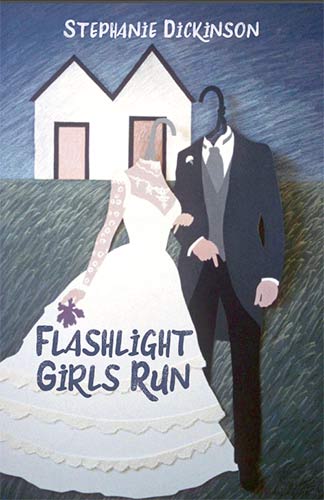
2017, New Meridian Arts, short stories
Stephanie Dickinson writes with the beauty of a wounded angel. The protagonists in these eleven stories are achingly real, so natural that they craft their own lives. Most, but not all, are women; most, but not all, are young. Each has met humanity’s dark underbelly—through war, predation, neglect, the crueler vagaries of family—and felt the jagged elbows of alienation. And yet, like the Flashlight Girls Run of the title, they power on with a particular awkward grace that makes these stories hard to put down, and impossible to forget. Gorgeous, heartbreaking, empowering stuff!
Susan O’Neill, author of Don’t Mean Nothing: Short Stories of Vietnam
Each story in Flashlight Girls Run digs deeply and honestly into the feelings of her characters. It delves into essences of ourselves to which we feel but lack words. In lyrical cadences, Stephanie Dickinson gives voice to love and tenderness amidst the setbacks of broken dreams, broken hearts, and broken bodies. A must read!
Henya Drescher, author
In this collection of stories Stephanie Dickinson brilliantly gives life to characters we rarely see in fiction— damaged vets, abandoned and crippled children, young women in precarious traps —by creating the small, perfect details that reveal their hopes and dreams.
Sarah McElwain, author, editor
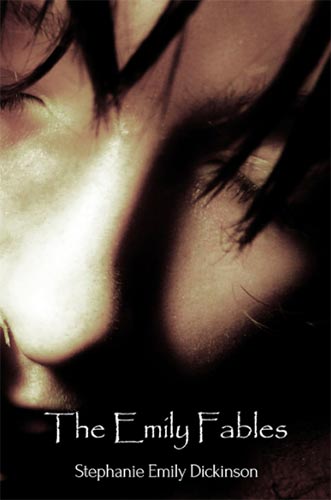
2016, ELJ Editions, fiction
All of Stephanie Dickinson's works are about language: taut, urgent, effervescent. Her extraordinary talent shimmies in the daylight of her paged ruminations, in the night of her haunting revelations. Reading Stephanie Dickinson is like being thrown back in time to a more careful, more erudite, era of writing rising off the wings of a brilliance seldom seen these days; maybe it's because her 'Emily' pieces speak of that gentler time. Yet next to Annie Dillard, I'm not sure I've met Dickinson's contemporary equal. Her works are all about the lucid, arresting turns of phrase that make language as surprising and re-readable as it should be.
Chila Woychik, essayist and editor of Eastern Iowa Review
In The Emily Fables, Dickinson’s writing changes the body/the being of anyone tough enough to read what she writes, how it makes that person gasp, makes that person's throat catch, heart skip skip a beat as word after word she nails something that has never before been nailed. She discovers for the reader something that before had no existence on the map of daily human beings and marks it out as a new a roadway. There Dickinson is, machete in hand, pick on the ground beside her, cutting a trail, digging out a byway, pointing out landmark after landmark along the way.”
Allen Brafman, author of Stone Feathers
“Danger is always palpably present in The Emily Fables. It travels with us as we follow Emily’s journey that geographically takes us no farther than the four corners of an Iowa farm. It is the un-nerving that we can’t shake. Sometimes we feel it is a spirit that lives within the narrator, a dybuk, that shares her mind, strums her emotions with its willful dissonances. It is a lyrical trip with a fallen angel and we wonder how she came to fall.”
Rosemary De Angelis, Director, New York Drama Desk Award Winning Actress
Available from ELJ BookNook
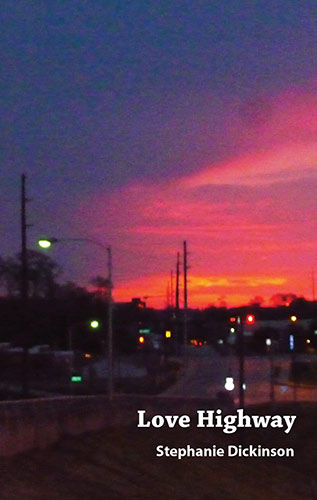
2015, Spuyten Duyvil, novel
Cover photo: Nava Renek
In order to know love, we must know its absence. This duality sets the stage of Stephanie Dickinson’s potent new novel, Love Highway. Nylah is smart but naïve, capable but insecure. She is drunk. She is being followed. Trinity is downtrodden but hopeful, distracted but street-smart. She is trapped. She is caught in the middle. These two women, love-injured and longing, are fading into the same gritty gray scenery. Their cravings are drawn with precise, cutting lines that pierce the vibrancy of love itself—bold, scenic and memorable. Love Highway is about those who feed on others’ hunger and the value of looking within, no matter how painful.
Jen Knox, author of Don’t Tease the Elephants
If you take a real crime, the Jennifer Moore murder, add the imagination, insight and humanity of Stephanie Dickinson, you have Love Highway. It’s as if Stephanie not only has access to diaries of real characters, but to their actual thought processes. Despite knowing the outcome, it’s suspenseful and reads as if it’s happening in real time. Halfway through I had to put the book down for a while--it felt too real, too harrowing, although not at all gory. And after putting it down it still stuck to me. Her fictionalization, based on the actual, realizes its emotional truth. Be forewarned, you can’t swallow this book, it’s too powerful. Like all truly great art, you’ve got to let it swallow you.
Ted Jonathan, author of Bones & Jokes
Love Highway by Stephanie Dickinson is a sensual and treacherous novel about desire and memory. Set in New York City and its outskirts, she gives us the shiny girls who will risk everything to be part of what they’ve been brainwashed into believing is bright and essential. Dickinson has a dense, lyrical prose style that infiltrates the senses like a walk through a hot-house full of lilies. In turns both exciting and shattering, this story unfolds silken with the worms still working the cloth.
Susan Tepper, author of The Merrill Diaries
Available from Spuyten Duyvil or Amazon.com
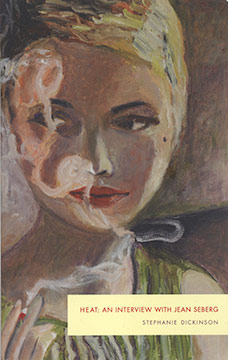
2013, New Michigan Press, essay
Cover artwork: Jill Hoffman
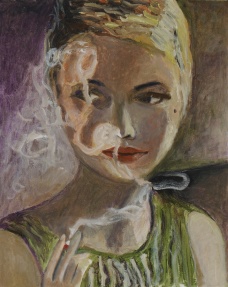 In Heat: An Interview with Jean Seberg, Stephanie Dickinson becomes the voice of a legendary movie star and the last All-American girl Jean Seberg. Written as a fictional interview, no question is off-limits (French husbands, love with a Black Panther, alcoholism, death of a child, suicide). The imaginary answers are real and haunting as they pull you into a fascinating world of the 1960s. Dickinson skillfully draws on her own Midwestern childhood and with heart-rending imagery gives us a portrait of a dreamy teenager in Marshalltown who "watched the bluegill bite the hook's surprise," a girl who could never shrug off her small-town roots even as she embraced the Paris life of celebrity. Every page is a story, an inner dialogue, a provocative meditation on Hollywood that is "no Babylonian Talmud," on beauty that "isn't a marzipan cookie," on destiny "you're whatever the script asks, lily or green toad." Dickinson has written a book of such depth, knowledge and sensitivity that it should be considered the star's authorized biography because had Jean Seberg read this she would have cried with joy at the prospect of finally being understood.
In Heat: An Interview with Jean Seberg, Stephanie Dickinson becomes the voice of a legendary movie star and the last All-American girl Jean Seberg. Written as a fictional interview, no question is off-limits (French husbands, love with a Black Panther, alcoholism, death of a child, suicide). The imaginary answers are real and haunting as they pull you into a fascinating world of the 1960s. Dickinson skillfully draws on her own Midwestern childhood and with heart-rending imagery gives us a portrait of a dreamy teenager in Marshalltown who "watched the bluegill bite the hook's surprise," a girl who could never shrug off her small-town roots even as she embraced the Paris life of celebrity. Every page is a story, an inner dialogue, a provocative meditation on Hollywood that is "no Babylonian Talmud," on beauty that "isn't a marzipan cookie," on destiny "you're whatever the script asks, lily or green toad." Dickinson has written a book of such depth, knowledge and sensitivity that it should be considered the star's authorized biography because had Jean Seberg read this she would have cried with joy at the prospect of finally being understood.
Marina Rubin, author of Stealing Cherries, Logic and Ode to Hotels
Life's an existential journey for Jean Seberg. It's not easy being a seething adolescent sex-pot, a free-love heroine of French New Wave films and Black Panthers, a mother, not to mention Joan of Arc burning at a funeral pyre under the direction of Otto Preminger. A film director or critic cuts through the fine façade between life onstage and off -- killing and resurrecting. "What's real is make-believe..." just as this interview is. Dickinson's great talent lies not in writing about Jean Seberg but in occupying that space between her spirit and her flesh. Dickinson speaks Seberg, sees Seberg, savors the humiliation of brutish critics until it sours, has felt heavy make up melting on her face, heard the sobs of butterflies alighting in her body's crevices, felt the heat rise from her torched costume, been trapped in a sack, taken to the anvil, hammered. Even then, says Seberg-Dickinson, "I'm deep in the sky. Alive."
Maria Lisella, author of Two Naked Feet, Amore on Hope St. and Thieves in the Family
Read an EXCERPT at the Pithead Chapel website where it was voted 'Best of the Net'.
Amazon.com

2013, Rain Mountain Press
A novel in stories for young adults
Cover photo: Lawrence Applebaum
This enigmatic Carve classic “Hybrid” by Stephanie Dickinson, follows thirteen-year-old prodigy Dalloway as she spends Easter vacation with her father and grandmother in Manhattan. Both father and grandmother constantly hog the spotlight, leaving Dalloway feeling largely invisible. (Those familiar with her namesake from Virginia Woolf’s novel may remember that Clarissa Dalloway, too, “had the oddest sense of herself being invisible”). Dalloway also has a preoccupation with hybrid animals and likens her family to them (her transgendered father being a cross between male and female; and her grandmother, having just undergone cosmetic surgery, being a cross between young and old). As Dalloway soon learns, she is consubstantial with her father and grandmother. She is nothing but a domesticated hybrid in the wilderness that is New York City. Just as the protected existence of Woolf’s Clarissa Dalloway had left her ignorant of the experience of the lower classes, so too is the Dalloway of this story ignorant of life outside her bubble. Bolstering this offbeat cautionary tale throughout is its gimlet humor. Dickinson also limns so well the frightening and majestic backdrop of New York, the “sexiest address in the world.” Thanks to Dickinson’s mesmerizing narrative, it’s easy for the reader to get lost in the city, even if just on the page.
Matthew Limpede, editor, Carve
Port Authority Orchids is a coming-of-age narrative that is by turns humorous, quirky, and tragic. Stephanie Dickinson offers the reader New York as seen by Dalloway, a precocious and idealistic teenage girl with a fractured, eccentric family in constant metamorphosis. Dickinson's eye for detail and narrative style entice the reader to sit up, look and listen for the next beautifully crazy scene. One of the many characters that stands out is the brazen, redwoodesque Great Aunt Dorna of "Sonic Ear," an elderly version of Astrid Lindgren's ultrafeminist Pippi Longstocking with an endless supply not of golden coins from a treasure chest, but of expensive sets of flatware and tableware that she offers, piece by piece, as currency. Dorna is the adult role model Dalloway deserves; together, they take on all those who would usurp or brutalize women on the streets. I am thrilled to see this collection of stories together at last.
Bonnie Ditlevsen, editor, Penduline
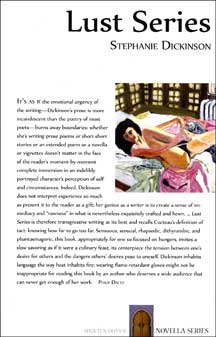
2011, Spuyten Duyvil Press
Prose Poems
Cover Artwork: Jill Hoffman
What a wonderful reading experience this is! In each of these brightly illuminated texts, we seem to have been air-dropped into a narrative whose details quickly establish themselves and fall into place as hints of a story break through the mesh of images. Stephanie Dickinson’s intuitive sense of drama finds expression in physical, sensual language that points to the origins
of what has led up to the moment described in each short account. While the language shifts
with the moods, the intensity never lets up.
David Chorlton
Visceral. Ecstatic. Language shimmers beneath the pen Stephanie Dickinson hones to a blade, wields like a knife: shank in the hands of the innocent prisoner who’s survived every enemy; scalpel in the grasp of a surgeon who knows that to save is to excise the rot. The immense power infusing all of Dickinson’s work is that she writes like her life depends on it; she’s the
anointed girl “rambling from roof to roof sweating starlight,” giving voice to the runaway and raped, the stalker and stalked, the imprisoned, kidnapped, deformed and deranged, nature run riot, run rot. She gives voice to the women taken in by the men “who talk a three-tier wedding cake,” the little deer (who tells of her killer), “He unfleshes my bones and says that
he’s dressing me.” Dickinson’s heart is expansive, her empathy unbound as she embraces the lives of both the innocent and their aggressors. In this beautiful book, Stephanie Dickinson masterfully gives witness to all of us finding ourselves at the mercy of our lusts.
Catherine Sasanov
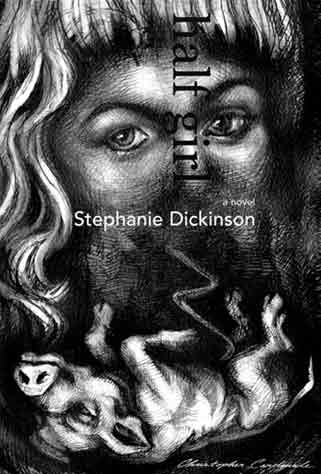
2008, Spuyten Duyvil, novel
Cover Artwork: Christopher Cardinale
In her debut novel, the aptly-named Stephanie Emily Dickinson (who also reminds me of a female Tennessee Williams) gives us Angelique, a sort of hitch-hiking Lolita, and somehow makes her heart break in the reader’s chest. Half Girl is 100% thrilling, harrowing, beautiful, and unforgettable.
Jennifer Belle, author of Going Down and High Maintenance
Stephanie Dickinson’s novel, Half Girl, pulls you under at once, and when you come up for air, you are astounded to be in the same room where you began. Each sentence is a surprise—a trip in the mind of a sharply sensual and adventurous girl who is leaving home and immediately finding danger in cold, lonely places. You read in fear of what might happen to her, but also with a blind faith in her hopeful determination.
Meredith Sue Willis, author of In the Mountains of America, Space Apart, Higher Ground, and Only Great Changes
Incisive and insightful doesn’t begin to describe the writing of Stephanie Dickinson. She has lived her work and enables her work to live in us. I don’t hesitate to say that long after many other writers have faded, Stephanie Emily Dickinson will be right there. Her namesake would be proud.
Chocolate Waters, Charting New Waters, Take Me Like a Photograph, a pioneer in the art of performance poetry, NEA fellow
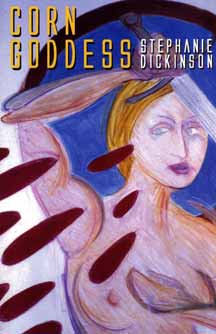
2007, Rain Mountain Press, poetry
Cover Artwork: Doug Dorph
Corn Goddess speaks to the sacred teenage time when a body blossoms and is maimed, about prairie and ramshackle farms and desolate cow lanes, the dirt’s remembering of recluses and long ago animal sex, about mothers, those angry and strong Midwestern women who feed their daughters the bone soup of self-hatred, and fathers who hunt the silver foxes running through farm girls’ imaginations. Corn Goddess describes the struggle to escape the seduction of gunnysacks and summer afternoons spent lying on cut hay after the balers have been through, of green corn and mystery growing in every direction, a fecund claustrophobia, and the darkness encountered once the wider world is found.
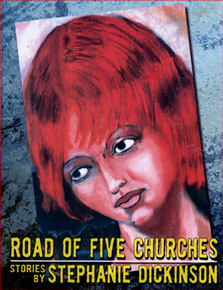
2006, Rain Mountain Press, stories
Cover Artwork: Michael Weston
In this debut collection of short stories told in lush, humid prose the protagonists are all young women, many of them teens, trying to survive the extreme situation. There is Hatchet, accused by her Lakota brethren of being an FBI informer; Trout, a fundamentalist Christian with four children and another on the way; Kimchee, a Korean orphan; and Jasmina, imported from the Balkans for the sex trade. In “Fire Maidens, ’57,” Monarch helps her father sick from the radioactive “death dust” kill himself. This is the above ground atomic bomb testing Nevada of the 1950s. “A Lynching in Stereoscope” is told in two first person accounts.
Ciz and Jelly weave an interlocking narrative of a woman lynched in 1930s Arkansas and a home health aide who discovers that the elderly brother and sister she’s caring for did more than witness the event as children. In the title story “Road of Five Churches,” two grifters, a mother and daughter who wander the south selling bogus vacuum sweepers, are revealed to be a grown missing toddler and the woman who abducted her. “Amiga Mom from Planet Iraq” tells the homecoming of Sgt. Bethany Telecky, a disabled Iraq War Veteran, whose job was detonating bombs in a country wanting to “blow itself up into smaller and smaller bits of dirt and dust.” She loses her left arm and part of her face in an IED explosion. An intense, lively read, often darkly humorous, these stories never fail to lyrically entertain.
REVIEWS:
